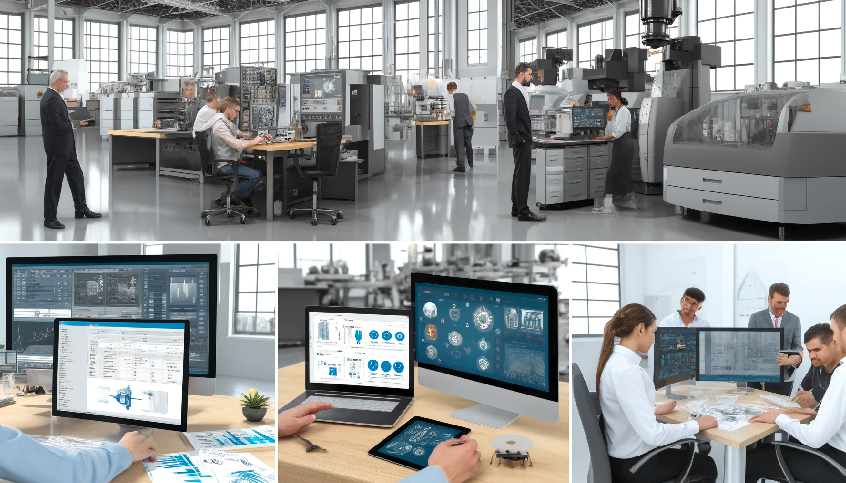
Improving Productivity & Efficiency in Manufacturing
By integrating and optimizing various processes, manufacturers can reduce costs, improve product quality, and enhance overall operational effectiveness.
Enterprise Resource Planning (ERP) Systems
ERP systems integrate various business processes and functions into a single comprehensive system. They provide real-time data and insights across departments, such as production, finance, human resources, and supply chain management. Key benefits include:
- Inventory Management: Real-time tracking of inventory levels helps avoid stockouts and overstock situations.
- Production Planning: Enhanced scheduling and planning capabilities ensure optimal use of resources and reduce downtime.
- Supply Chain Optimisation: Improved visibility into the supply chain helps in identifying bottlenecks and improving supplier relationships.
Manufacturing Execution Systems (MES)
MES software monitors, controls, and manages production processes on the shop floor. It collects data in real-time from machines and operators, providing insights into production performance and product quality. MES helps in:
- Reducing Waste: By identifying inefficiencies and areas of waste in the production process.
- Quality Control: Ensuring products meet quality standards by monitoring production parameters and implementing corrective actions promptly.
- Production Tracking: Keeping track of work-in-progress and ensuring that production schedules are adhered to.
Maintenance Management Software
Computerised Maintenance Management Systems (CMMS) help in planning, tracking, and optimising maintenance activities. Effective maintenance management ensures machinery operates efficiently, minimising downtime and extending equipment lifespan. CMMS features include:
- Preventive Maintenance Scheduling: Automating maintenance schedules based on machine usage and condition to prevent unexpected breakdowns.
- Work Order Management: Streamlining the creation, assignment, and tracking of maintenance tasks.
- Asset Management: Maintaining detailed records of all machinery and equipment, including repair history and performance metrics.
Supply Chain Management (SCM) Software
SCM software enhances the efficiency of supply chain operations by providing tools for procurement, logistics, and inventory management. It helps in:
- Demand Forecasting: Using historical data and market trends to predict future demand, ensuring optimal inventory levels.
- Supplier Management: Evaluating and selecting suppliers based on performance metrics, lead times, and costs.
- Logistics Optimisation: Planning and optimising transportation routes to reduce costs and improve delivery times.
Data Analytics and Business Intelligence (BI)
BI and data analytics tools process vast amounts of data generated by various systems within the manufacturing environment. These tools provide actionable insights through dashboards and reports, helping managers make informed decisions. Benefits include:
- Performance Monitoring: Tracking key performance indicators (KPIs) to measure efficiency, productivity, and quality.
- Trend Analysis: Identifying trends and patterns that can inform strategic planning and operational improvements.
- Predictive Analytics: Using advanced algorithms to predict future outcomes and optimise production processes accordingly.
Lean Manufacturing Software
Lean manufacturing software supports the implementation of lean principles aimed at reducing waste and improving efficiency. Features typically include tools for value stream mapping, 5S, and Kaizen. Lean software helps in:
- Process Improvement: Identifying and eliminating non-value-added activities.
- Continuous Improvement: Facilitating ongoing efforts to improve processes and products.
- Standard Work: Documenting and standardising best practices to ensure consistent quality and efficiency.
Workforce Management Software
Workforce management software optimises the utilisation of human resources by managing employee schedules, time tracking, and labour costs. Key functionalities include:
- Scheduling: Creating optimised work schedules that align with production needs and employee availability.
- Time and Attendance: Tracking employee hours and attendance to ensure accurate payroll processing and compliance with labour regulations.
- Performance Management: Monitoring and evaluating employee performance to identify training needs and recognise high performers.
To conclude,
Enhancing productivity and efficiency in manufacturing is critical for maintaining competitiveness and achieving sustainable growth. Integrating and optimizing various processes allows manufacturers to reduce costs, improve product quality, and enhance overall operational effectiveness. This integration is facilitated by various software systems that streamline operations and provide valuable insights.